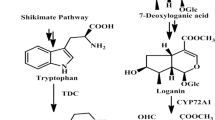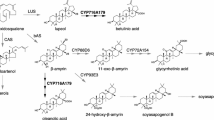Abstract
Plant cytochrome P450s are involved in the biosynthesis of various classes of secondary metabolites. To elucidate the biosynthesis of zerumbone, a sesquiterpenoid with multiple potential anticancer properties, a family of P450 genes expressed in rhizomes of Zingiber zerumbet Smith, were cloned using a PCR-based cloning strategy. After functional expression in yeast, one of these P450s was found to convert α-humulene into 8-hydroxy-α-humulene, a proposed intermediate of zerumbone biosynthesis. This P450 has been designated CYP71BA1, a new member of the CYP71 family. CYP71BA1 transcripts were detected almost exclusively in rhizomes and showed a similar expression pattern to ZSS1 transcripts during rhizome development. Coexpression of a gene cluster encoding four enzymes of the mevalonate pathway with CYP71BA1 and ZSS1 in Escherichia coli leads to the production of 8-hydroxy-α-humulene in the presence of mevalonate, suggesting the possibility of microbial production of this zerumbone intermediate from a relatively simple carbon source by metabolic engineering.






Similar content being viewed by others
Abbreviations
- ATR2:
-
Arabidopsis P450 reductase 2 gene
- MK:
-
Mevalonate kinase
- PMK:
-
Phosphomevalonate kinase
- MPPD:
-
Mevalonate diphosphate decarboxylase
- IPPI:
-
Isopentenyl diphosphate isomerase
- IPP:
-
Isopentenyl diphosphate
- DMAPP:
-
Dimethylallyl diphosphate
- CPR:
-
Cytochrome P450 reductase
References
Dai JR, Cardellina JH, McMahon JB, Boyd MR (1997) Zerumbone, an HIV-inhibitory and cytotoxic sesquiterpene of Zingiber aromaticum and Z. zerumbet. Nat Prod Lett 10:115–118
Ozaki Y, Kawahara N, Harada M (1991) Anti-inflammatory effect of Zingiber cassumunar Roxb. and its active principles. Chem Pharm Bull 39:2353–2356
Murakami A, Takahashi D, Kinoshita T, Koshimizu K, Kim HW, Yoshihiro A, Nakamura Y, Jiwajinda S, Terao J, Ohigashi H (2002) Zerumbone, a Southeast Asian ginger sesquiterpene, markedly suppresses free radical generation, proinflammatory protein production and cancer cell proliferation accompanied by apoptosis: the α, β-unsaturated carbonyl group is a prerequisite. Carcinogenesis 23:795–802
Kirana C, McIntosh GH, Record IR, Jones GP (2003) Antitumor activity of extract of Zingiber aromaticum and its bioactive sesquiterpenoid zerumbone. Nutr Cancer 45:218–225
Sharifah-Sakinah SA, Tri-Handayani S, Azimahtol-Hawariah LP (2007) Zerumbone induced apoptosis in liver cancer cells via modulation of Bax/Bcl-2 ratio. Cancer Cell Int 7:4–15
Xian MJ, Ito K, Nakazato T, Shimizu T, Chen CK, Yamato K, Murakami A, Ohigashi H, Ikeda Y, Kizaki M (2007) Zerumbone, a bioactive sesquiterpene, induces G2/M cell cycle arrest and apoptosis in leukemia cells via a Fas- and mitochondria-mediated pathway. Cancer Sci 98:118–126
Murakami A, Tanaka T, Lee JY, Surh YJ, Kim HW, Kawabata K, Nakamura Y, Jiwajinda S, Ohigashi H (2004) Zerumbone suppresses skin tumor initiation and promotion stages in mice: involvement of induction of anti-oxidative and phase II drug metabolizing enzymes and inhibition of NF-kB-mediated cyclooxygenase-2 expression. Int J Cancer 110:481–490
Martin VJJ, Pitera DJ, Withers ST, Newman JD, Keasling JD (2003) Engineering a mevalonate pathway in Escherichia coli for production of terpenoids. Nat Biotechnol 21:796–802
Pitera DJ, Paddon CJ, Newman JD, Keasling JD (2007) Balancing a heterologous mevalonate pathway for improved isoprenoid production in Escherichia coli. Metab Eng 9:193–207
Newman JD, Marshal J, Chang M, Nowroozi F, Paradise E, Pitera D, Newman KL, Keasling JD (2006) High-level production of amorpha-4,11-diene in a two-phase partitioning bioreactor of metabolically engineering Escherichia coli. Biotechnol Bioeng 95:684–691
Harada H, Misawa N (2009) Novel approaches and achievements in biosynthesis of functional isoprenoids in Escherichia coli. Appl Microbiol Biotechnol 84:1021–1031
Yu FN, Okamoto S, Nakasone K, Adachi K, Matsuda S, Harada H, Misawa N, Utsumi R (2008) Molecular cloning and functional characterization of α-humulene synthase, a possible key enzyme of zermbone biosynthesis in shampoo ginger (Zingiber zerumbet Smith). Planta 227:1291–1299
Chau M, Croteau R (2004) Molecular cloning and characterization of a cytochrome P450 taxoid 2α-hydroxylase involved in Taxol biosynthesis. Arch Biochem Biophys 27:48–57
Ralston L, Kwon ST, Schoenbeck M, Ralston J, Schenk DJ, Coates RM, Chappell J (2001) Cloning, heterologous expression, and functional characterization of 5-epi-aristolochene-1, 3-dihydroxylase from tobacco (Nicotiana tabacum). Arch Biochem Biophys 393:222–235
Luo P, Wang YH, Wang GD, Essenberg M, Chen XY (2001) Molecular cloning and functional identification of (+)-delta-cadinene-8-hydroxylase, a cytochrome P450 mono-oxygenase (CYP706B1) of cotton sesquiterpene biosynthesis. Plant J 28:95–104
Teoh KH, Polichuk DR, Reed DW, Nowak G, Covello PS (2006) Artemisia annua L. (Asteraceae) trichome-specific cDNAs reveal CYP71AV1, a cytochrome P450 with a key role in the biosynthesis of the antimalarial sesquiterpene lactone artemisinin. FEBS Lett 580:1411–1416
Pompon D, Louerat B, Bronine A, Urban P (1996) Yeast expression of animal and plant P450s in optimized redox environments. Methods Enzymol 272:51–64
Urban P, Mignotte C, Kazmaier M, Delorme F, Pompon D (1997) Cloning, yeast expression, and characterization of the coupling of two distantly related Arabidopsis thaliana NADPH-Cytochrome P450 reductases with P450 CYP73A5. J Biol Chem 272:19176–19186
Harada H, Yu FN, Okamoto S, Misawa N, Utsumi R (2009) Efficient synthesis of functional isoprenoids from acetoacetate through metabolic pathway-engineered Escherichia coli. Appl Micro Biotech 81:915–925
Nelson DR, Strobel HW (1988) On the membrane topology of vertebrate cytochrome P-450 proteins. J Biol Chem 263:6038–6050
Durst F, Nelson DR (1995) Diversity and evolution of plant P450 and P450-reductases. Drug Metab Drug Interact 12:189–206
Chapple C (1998) Molecular genetic analysis of plant cytochrome P450-dependent monooxygenases. Annu Rev Plant Physiol Plant Mol Biol 49:311–343
Takahashi S, Yeo YS, Zhao Y, O’Maille PE, Greenhagen BT, Noel JP, Coates RM, Chappell J (2007) Functional characterization of premnaspirodiene oxygenase, a cytochrome P450 catalyzing regio- and stereo-specific hydroxylations of diverse sesquiterpene substrates. J Biol Chem 282:31744–31754
Nguyen DT, Gopfert JC, Ikezawa N, MacNevin G, Kathiresan M, Conrad J, Spring O, Ro DK (2010) Biochemical conservation and evolution of germacrene A oxidase in Asteraceae. J Biol Chem 285:16588–16598
Chang MC, Eachus RA, Trieu W, Ro DK, Keasling JD (2007) Engineering Escherichia coli for production of functionalized terpenoids using plant P450s. Nat Chem Biol 3:274–277
Ro DK, Arimura GI, Lau SYW, Piers E, Bohlmann J (2005) Loblolly pine abietadienol/abietadienal oxidase PtAO (CYP720B1) is a multifunctional, multisubstrate cytochrome P450 monooxygenase. Proc Natl Acad Sci USA 102:8060–8065
Yu FN, Harada H, Yamasaki K, Okamoto S, Hirase S, Tanaka Y, Misawa N, Utsumi R (2008) Isolation and functional characterization of a β-eudesmol synthase, a new sesquiterpene synthase from Zingiber zerumbet Smith. FEBS Lett 582:537–542
Acknowledgments
We thank Mr. T. Ishida, Ms. R. Sawa, and Mr. H. Miyawaki for providing the ginger plants. We are also grateful to Dr. D. Pompon (CNRS, Gif-sur-Yvette, France) for providing the yeast expression system. This work was supported in part by the Research and Development Program for New Bio-industry Initiatives (2006–2010) from the Bio-oriented Technology Research Advancement Institution (BRAIN), the “Academic Frontier” Project for Private Universities: Matching fund subsidy from the Ministry of Education, Culture, Sports, Science and Technology (2004–2008), and the Sasagawa Scientific Research Grant from the Japan Science Society.
Author information
Authors and Affiliations
Corresponding author
Additional information
F. Yu and S. Okamoto contributed equally to this work.
Rights and permissions
About this article
Cite this article
Yu, F., Okamoto, S., Harada, H. et al. Zingiber zerumbet CYP71BA1 catalyzes the conversion of α-humulene to 8-hydroxy-α-humulene in zerumbone biosynthesis. Cell. Mol. Life Sci. 68, 1033–1040 (2011). https://doi.org/10.1007/s00018-010-0506-4
Received:
Revised:
Accepted:
Published:
Issue Date:
DOI: https://doi.org/10.1007/s00018-010-0506-4




